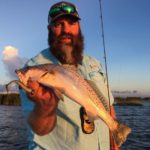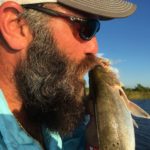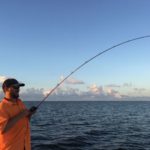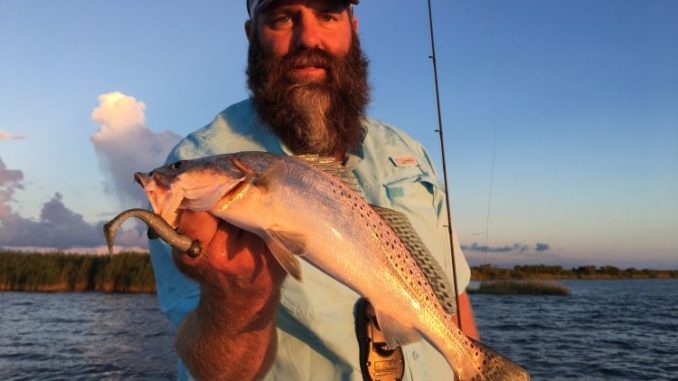
Go on the right day this time of year, and you can almost will Dularge speckled trout into existence.
Capt. Lloyd Landry is apparently a master of black magic. It’s clear he spends his free time reading tarot cards, casting tea leaves and studying the works of Aleister Crowley.
How else to explain the man’s ability to peer hours into the future and foretell events?
The sun was still tucked in its bed below the eastern horizon when Landry backed his Realtree-wrapped Ford pickup onto the gravel parking area in front of his boat dock. His son, Lloyd Landry V, “Five” to his friends and family, stretched in the passenger seat before unfolding his long legs and dropping them out the open door.
The elder Landry moved toward a locked shed, and answered a question that was unasked, but still hung in the thick, humid air.
“I know they’re catching keeper trout all along the coast, but it hasn’t happened here yet,” he said. “You can catch all you want, but maybe one out of 30 will measure (12 inches).
“We had a full moon last night, so maybe that will change today.”
The affable Landry moved with easy motion for such a mountain of a man, talking and laughing as he and “Five” stowed gear in the boat and shoved off for the 15-minute run into Lake Mechant, a semiannual spring and autumn hotspot.
The eastern horizon had begun to turn pink, and a bright moon hung to the west, shooting lasers of light across the ruffled surface as the big Lake & Bay moved south and then west.
Non-stop action
Landry promised seagulls would collect and dive on shrimp in Mechant after sunrise, but he wanted to fish near the mouth of a drain since the tide was falling. He shot across the lake, and eased back on the throttle. The sun had still not breached the horizon.
“Spots like this are where the fish show up first,” Landry said. “In a couple weeks, the birds will have keepers under them, but not yet.”
Landry tossed a tight-lined shrimp creole-colored Matrix Shad toward an isolated patch of roseau cane along the shoreline, and hoped his full-moon prediction would come true. A few fruitless casts later, however, he was surely having his doubts.
But then the sun poked its nose over the horizon, and it was like every speckled trout in South Louisiana punched in for work. Landry missed a fish a second before Five buried the hook in one. Landry reeled in, and made another cast. This time, the fish wasn’t so lucky.
The father-and-son team proceeded to waylay the speckled trout. They didn’t measure a single fish because all were clearly longer than Louisiana’s 12-inch size minimum.
That’s how quickly the fall bite begins in the marshes around Dularge. One day the fish aren’t there, and the next day they are. Once they show up, the action is absurdly predictable. All an angler has to do is motor his boat from his favorite launch spot into Lake Mechant or Sister Lake (called Caillou Lake on most maps).
“Those lakes are always consistent in the fall, and no matter what direction the wind blows, you can find a fishable shoreline,” Landry said. “That gives you a lot of options, especially on a falling tide. You’ll get that clean, black water coming out of all those tributaries — those bayous, ditches and ponds. That’s where your fish will congregate.”
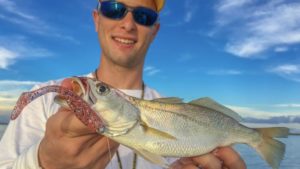
Must-have lure colors for Dularge specks
That was certainly true on this trip. Lake Mechant wasn’t exactly dirty, but the water was a stained green color. Clear water being sucked by the falling tide out the cut Landry fished formed a ragged boundary with the more opaque lake water. The keeper fish were all in the clear stuff, feasting on shrimp riding the conveyor belt of the tide out of the marsh.
The little crustaceans had plenty of company throughout the region, as evidenced by the residue from a tropical storm that hit the Alabama coast just a couple weeks earlier.
“There are white shrimp all the way to Falgout Marina,” Landry said. “When (Tropical Storm Gordon) pushed through, the water got high and came over our docks and into the boat sheds. I’d come down each morning, and I’d have little dead shrimp on my dock. I mean, think of how far up (in the estuary) that is.”
In that clear water, Landry likes to throw shrimp creole-colored Matrix Shads almost exclusively. In the more stained waters of the lakes, he’ll go with the green hornet color.
A bumper crop of shrimp seems to be the norm for the Dularge area, and it feeds the ecosystem year ‘round. Whether it’s white shrimp in the summer and fall that linger on through the winter or brown shrimp in the spring, speckled trout almost always have their favorite food around.
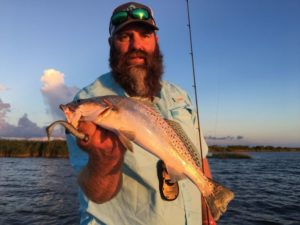
That’s why last spring Landry relocated his successful guide business from Buras, where he spent his entire career, to Dularge.
“The fishing is just so good here,” Landry said. “It’s like the old days. Most of the time, it’s just easy, easy.
“The area is just so vast. My clients meet me at Falgout Marina, and on a Saturday, there’s a line and a hundred boats in the water, but then you go fishing, and all day you might see 10 boats. You can fish everything from Cocodrie to the Atchafalaya River, all from that one location. You have all that area to fish trout, but if it’s really windy, you can tuck back in this marsh and catch all the redfish you want.”
Redfish rig
Even successful trout days often end with Landry back in the marshes catching the spottails. When he’s got clients, he targets them an unusual way, with a green hornet-colored Matrix Shad fished only a foot beneath a 4 Horsemen cork.
“It’s easier for clients to fish a cork,” he said. “They can throw it up toward the bank and watch it. The cork will tell them when they’ve got a bite. They don’t have to work it and fish based on feel.”
That technique is most effective, Landry said, in ponds with scattered grass. Some of his favorites have hydrilla and coontail topping out at about 18 inches below the surface. He fishes directly over the grass.
In ponds that hold more matted grass, he fishes the edges of the mats.
“Guys want to fish the bank, but that will kill you in a pond like that,” he said. “Those fish are using the matted grass as a bank. They’re just cruising along the grass beds looking for something to eat — crabs, shrimp and mullet.”
On a falling tide, Landry looks for ponds that have ditches — “trenasses” in South Louisiana parlance — pulling pretty water and bait out of the back marshes.
“It’s common this time of year to sit at one mouth and catch your limit,” he said.
That didn’t happen on the recent trip. Landry just couldn’t drag himself away from the keeper speckled trout that he had almost willed into existence.
Lloyd Landry, a modern-day Marie Laveau.
Don’t ignore speckled trout’s close cousins
After leaving feeding speckled trout to discover where else he could find them, Capt. Lloyd Landry ran into numerous schools of white trout that bit with more ferocity than emaciated lions.
Landry put the bigger ones in his onboard cooler, along with the speckled trout.
Some of the fish hit soft-plastics suspended under popping corks, but most fell for those same baits drug across the bottom. In certain areas, the bites were incessant.
“They’re always around this time of year,” Landry said. “That’s one thing you can always count on.”
